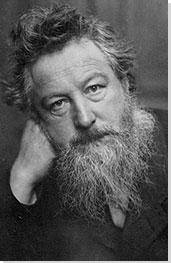Summary of William Morris
Few artists left such a wide and indelible mark on the art, culture, and politics of their era as William Morris did on the second half of the nineteenth century. Training first as a priest and then as an architect before abandoning both to realize his visions of medieval arcadia in the company of the Pre-Raphaelites, he moved between artistic and literary media throughout his life. Initially producing paintings in the sweet Quattrocento style of his Pre-Raphaelite contemporaries, most notably Dante Gabriel Rossetti, he soon branched out into architecture and interior design, creating some of the most commercially successful and enduringly admired textile patterns and furnishings in British art history. Towards the end of his life, Morris focused with increasing singularity on the radical political ambitions which had always underpinned his practice, publishing utopian socialist fantasy literature, and consolidating his lifelong work as a poet. When he died in 1896, he had not only left a deep imprint on the century he had lived through, but also laid the groundwork for many of the artistic, architectural and political projects which defined the next.
Accomplishments
- William Morris is often seen as the grandfather of the international Arts and Crafts Movement. In an era of increasing industrialism and urbanization, he embraced an idealized vision of the artisanship and cottage industries of the Middle Ages. For Morris, art was nothing if it was not a product of craftsmanship: a collaborative, spiritually imbued activity by which human beings grew together in kinship, and in connection to their natural environment. Inspired partly by the art historian John Ruskin, Morris's Arts and Crafts aesthetic directly or indirectly influenced a huge swath of artistic and literary movements over the coming decades, from Art Nouveau to the artists' books of the Futurists and Dadaists.
- William Morris was the first artist of the modern era to combine word and image in the expression of his vision. Following in the footsteps of that other great London-born radical and luminary William Blake, Morris developed an aesthetic in which the words printed on a hanging tapestry, for example, or in a hand-printed manuscript, were as reliant on their surrounding pattern-work for meaning as the images were on the text. This notion of a multi-media art practice, though realized in the context of a nostalgic medievalism, pre-empted the more overtly radical art-and-language experiments of the twentieth century, from Constructivist book design to Concrete Poetry.
- Like his mentor Rossetti, William Morris preferred to work in the company of friends, creative collaborators with whom he shared an artistic and spiritual worldview. It has often been argued that these collective endeavors, like those of the Pre-Raphaelite Brotherhood to which Morris was partially connected, pre-empt the notion of the avant-garde which held sway over radical artistic culture for much of the following century. If the definition of the avant-garde involves a radical, collective aesthetic vision infused with utopian political aims, then Morris's and his companions' activities certainly fit the bill.
Important Art by William Morris
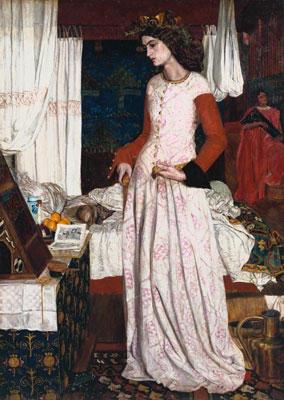
La Belle Iseult
Although this painting has been listed since its creation as 'unfinished', it is the only easel painting by Morris to reach this level of near-completion, and a quintessential work of Pre-Raphaelite-era portraiture. The model for the painting was Jane Burden, Morris's soon-to-be wife, and it is believed that he started work on it very early during their courtship. The artist reportedly struggled during the composition process with the proportions of the human body, which he was never able to execute as effectively as his peers. It is rumored that when he stopped working on the painting, he scribbled a note on the back to Jane: "I cannot paint you, but I love you".
Jane poses as the female protagonist of the story of Tristram and Iseult (Tristan and Isolde), a legend of Celtic origin made popular during the medieval period by the treatment of Thomas Mallory, on which Morris based his composition. The narrative of doomed lovers contains all the aspects of Medieval romance - thwarted desire, chastity, honor, chivalry - that attracted the Pre-Raphaelites to the literature and art of the period. In the scene depicted, Iseult is mourning the exile of Tristram - a knight sent to fetch her from Ireland to marry King Mark of Cornwall, only for the two to fall in love en route - from her husband's court. The tale was one that Morris had previously represented in the Oxford Union Murals, and the influence of the Pre-Raphaelite artists with whom he undertook that project, particularly Rossetti, is obvious. At the same time, we might trace a thread of affinity with the nascent Symbolist movement in continental Europe, given the heavily allegorical nature of the composition. The dog on the bed, given to Iseult by Tristram in Mallory's story, stands for loyalty, the rosemary in her crown for remembrance.
The painting also alludes in various ways to Morris's artistic and personal biography. Whilst figural painting would never be his true calling, we can sense clues as to his future endeavors as a designer and craftsman in the finer details of the scene. On the bed is an illuminated manuscript similar to those Morris would produce with Kelmscott Press, while the lavish textiles and tapestries are reminiscent of those Morris would spend most of his career creating. As for his model, Jane's strong, striking features, which epitomized the Pre-Raphaelite ideal of beauty, also caught the attention of Morris's friend and mentor Rossetti, with whom Jane embarked on a lifelong affair, grudgingly tolerated by her husband.
Oil on Canvas - Collection of the Tate, United Kingdom
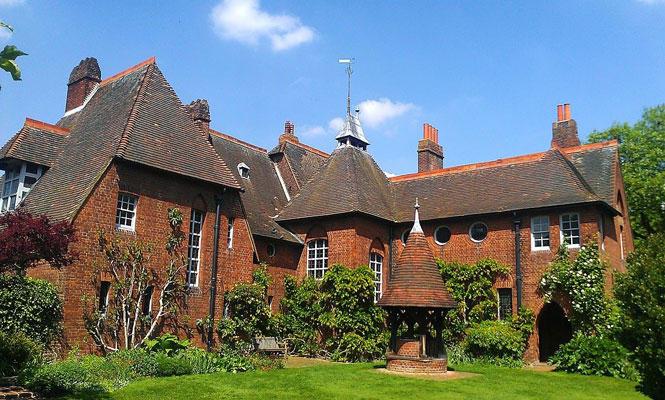
Red House
Created in collaboration with the architect Philip Webb, many consider this building the jewel in Morris's crown. After his marriage to Jane, Morris longed for a country home for the family, a place where he could live out his visions of medieval romance and collaborative creativity. The result was a strange and magnificent red brick construction which brought together the pointed arches of Gothic religious architecture, the gabled roofs of a Tudor mansion, and turrets from a medieval fairytale. This was not just a house to be lived in, but to be explored and experienced: for Rossetti, it was "more a poem than a house".
Everything in the creation and decoration of Red House was carefully considered. Perhaps in a nod to Morris's growing socialist principles, the red bricks of working-class housing were favored over the stone blocks that would have befitted his class status. He also abandoned bourgeoise taste by filling the garden with native British trees and flowers - those which inspired his decorative designs - rather than the exotic plants favored by the upper classes.
The decoration of the house has become as famous as its architecture, a collaborative endeavor involving not just Morris and Webb, but all of their artistic friends as well. Apparently, whenever a guest arrived to view the completed building, they would be invited to assist with its decoration. Morris would even prick out his designs in plaster, for less creatively inclined friends. The result is a work of interior decoration which showcases the talents of some of the best-known artists of the era. Murals, painted panels and chests, stained-glass windows and textiles: all were created in the spirit of collective joy and industry that Morris so valued.
Red House has been seen as the ancestral home of the Arts and Crafts Movement in Britain. Its construction also marked a decisive shift in architectural aesthetics, one whose effects were still playing out in the early twentieth century. In 1904, the German critic Hermann Muthesius described Red House as "the first house to be conceived and built as a unified whole, inside and out, the very first example in the history of the modern home". This concept would be hugely influential on architects of the Art Nouveau era such as Charles Rennie Mackintosh, and modernists such as Walter Gropius. 150 years after its construction, the building, now owned by the National Trust, continues to fascinate and excite visitors.
Bexleyheath, England
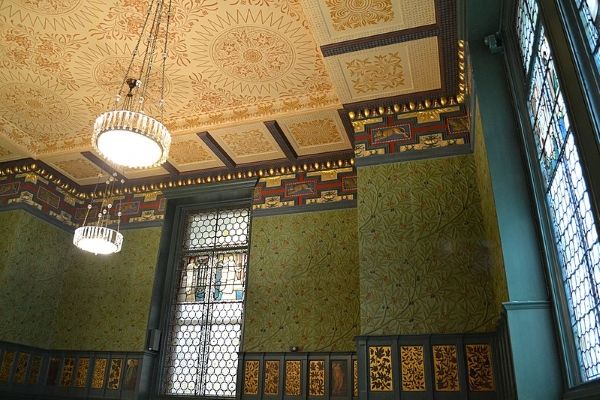
Green Dining Room
This Green Dining Room (also knonw as the Morris Room) is one of three refreshment rooms created for the South Kensington Museum (now the Victoria and Albert Museum) during the 1860s. This commission was not given to Morris alone, but to Morris, Marshall, Faulkner & Co., the company known as The Firm. The prestige of this commission was a testament to the critical and commercial success that Morris and his collaborators had been enjoying since establishing The Firm in 1861. The individuals chiefly involved in this project were Morris, Philip Webb, and Edward Burne-Jones. As with their other joint-endeavors, each worked on the sections of the room that best suited their skills. The Green Dining Room thus embodies the spirit of collaborative artisanship which the company championed.
As the resident architect of the group, Webb designed the window frames, working with Morris on the floral and geometric designs pricked into the plaster of the ceiling. Burne-Jones painted the paneled frieze along the walls of the room, and, as an accomplished stained-glass designer, filled the window panels with scenes of medieval domestic bliss, including the ubiquitous, lissome Pre-Raphaelite beauties. The patterns inscribed into the green-painted plaster walls were the work of Morris alone, however. Olive boughs, raised up in the plaster, wrap around the room in an endless pattern, punctuated by the splashes of color introduced by flowers and berries. While these walls were created as reliefs, the designs pre-empt those Morris would later create for wallpapers and furnishing fabrics, particularly Willow. The latter is one of Morris's best-known designs, a simple pattern of intertwined willow leaves that gives the "unmistakable suggestions of gardens and fields" within a domestic setting.
Plaster, paint, wooden panel, and stained glass - Victoria and Albert Museum, London
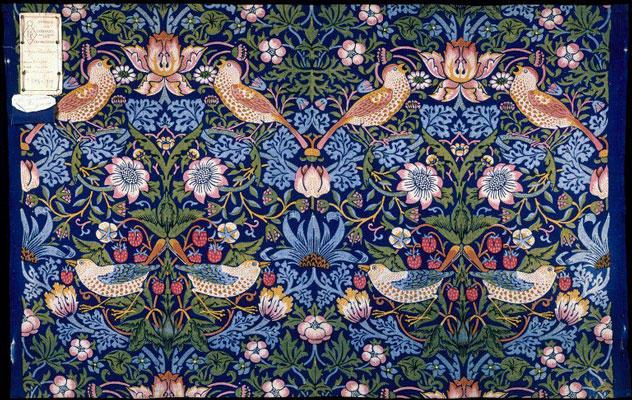
Strawberry Thief
Strawberry Thief is the best known of Morris's decorative textile designs, one on which he worked for several months before finding a way of printing it successfully. The fabric was intended to be used for curtains or hung along walls, a medieval style of decoration which the artist advocated. The pattern, meanwhile, was based on the thrushes that would steal strawberries from the kitchen in his country home at Kelmscott Manner, and was therefore imbued with nostalgic sentiment. Whilst the foliate designs are complex and eye-catching, and the design provides little depth between foreground and background, the birds remain a focal point due to their light color and the naturalism of their rendering. They also create an element of narrative interest, as the mischievous protagonists of a story that plays out across the surface of the fabric, entertaining with their song while they make away with the precious berries.
These themes are redolent of the natura naturans spirit of much medieval textile art, and loosely evocative of the romance and fantasy narratives of the same era. In practical terms, Morris took a great deal of interest in the practical craftsmanship of the Strawberry Thief design, learning the theory of fabric-dyeing and block-printing in order to create a pattern amenable to his chosen production process. Eventually, he settled on the ancient technique of indigo discharge, in spite of its costly and laborious nature, applying bleached blocks to dyed fabric. His main concern was the depth of color in the finished product, and the artisanal authenticity of the creative process.
This design has attained extraordinary commercial success since its release in the late nineteenth century, and continues to sell widely, with English department stores having featured it in several high-end fashion collaborations. Its popularity has recently led the Victoria and Albert Museum's designer-in-residence to create a digital game based on the design, while contemporary artists continue to look back to it. The conceptual and video artist Jeremy Deller, for example, has named an exhibition after the work, and created the piece Strawberry Thief (2014), a neon light depicting one of the birds with a captured berry, in homage to it.
Indigo-discharged and block-printed cotton - Victoria and Albert Museum, London
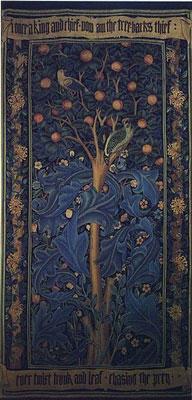
Woodpecker Tapestry
Most of Morris's best-known tapestry designs were created in collaboration with artists, such as Philip Webb and Edward Burne-Jones. The classic design for Woodpecker Tapestry, however, is the product of his imagination and technical skill alone. Standing at three meters high, the work was devised on a grand scale, originally intended to be hung in a billiard room in London. It depicts a woodpecker and songbird in a tree; above and below are two scrolls, bearing an inscription that would later be published as one of a series of "Verses for Pictures" in Morris's Poems By the Way (1891): "I once a king and chief/ now am the tree bar's thief/ ever twixt trunk and leaf/ chasing the prey". This playful little poem is based on a tale from the Roman poet Ovid's Metamorphoses, in which the sorceress Circe curses King Picus to become a woodpecker, after he spurns her sexual advances.
The extent to which Morris drew from medieval sources is abundantly clear from the design of this work: not only in its gothic lettering and busy pattern-work, but from the decision to employ tapestry as an artistic medium. Whilst hand-woven textiles had lined the halls of royal courts in the Middle Ages, by the nineteenth century tapestry had fallen far from fashionable taste. Morris remedied this not only by creating various modern takes on medieval tapestry patterns, but also by learning the craft himself. Synthesizing these ancient sources of inspiration with a modern attitude to nature, he created a decorative design that is as complex in thematic association as it is beautiful.
The combination of words and image, that is, means that the viewer is not only invited to follow the curves of trunk and branch, but also to contemplate the allegorical value of the illustration. Perhaps the poem contains a kernel of Morris's socialist worldview. The king appears to mourn his fall from power, but it is easy to question the validity of his lament: how can he mourn in such a beautiful natural setting?
Wool on Cotton - William Morris Gallery, London
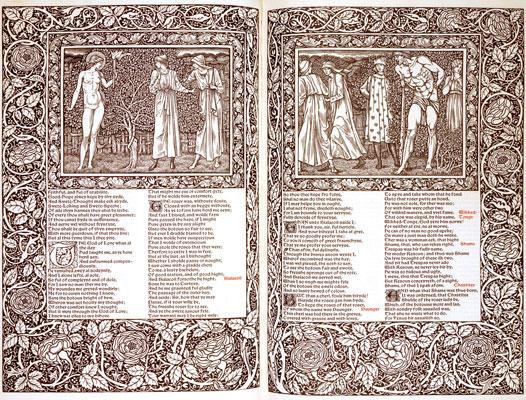
The Works of Geoffrey Chaucer now Newly Imprinted
The Kelmscott Chaucer, as it is widely known, is one of the defining achievements of the last great artistic project of Morris's life, the Kelmscott Press. For over two decades, Morris had enjoyed translating and illustrating medieval narratives, and he had gifted several hand-made manuscripts to family and friends. In 1891, he decided to set up a business that would produce beautiful handprinted books, spending months sourcing the correct handmade papers, woodblock carvers, and typefaces for the Kelmscott Press to use. In the case of the Kelmscott Chaucer, the medieval-style typeface originally chosen did not create the desired visual effect, and so an entirely new typeface, "Chaucer", was created solely for the project.
The Kelmscott Chaucer was the result of several years' labor involving Morris and his close friend Edward Burne-Jones. Morris designed foliate patterns for the pages, whilst Burne-Jones lent his decorative skills to the illustrated panels. The two then collaborated on the overall format and design of the book, while the artist and engraver William Harcourt Hooper etched the pages for printing. Less than 500 copies were made, each costly to produce and buy. They turned reading into a luxurious experience, to be appreciated visually as well as intellectually. Each page was to be savored, the words of the fourteenth-century poet placed in an aesthetic space inspired by the world in which they were written. Burne-Jones described The Kelmscott Chaucer as the culmination of the ideas that he and Morris had shared since they were students, finally brought to fruition "at the end of our days". Morris only just lived to see the release of the book, dying just a few months later in 1896.
The pages of the Kelmscott Chaucer have provided enjoyment and inspiration for artists and craftsmen ever since they were published. For his 2015 installation work Announcer, the contemporary artist David Mabb covered the walls of a gallery space with facsimiles of the Kelmscott Chaucer and the Russian Constructivist artist El Lissitzky's edition of the revolutionary poet Vladimir Mayakovsky's For the Voice. Both books are the product of utopian socialist ideals, and of an approach to book-making that was both artisanal and avant-garde.
Woodblock-printed pages - British Library, London
Biography of William Morris
Childhood
William Morris was born in 1834 in Walthamstow, Essex, the third of nine children. William's father, after whom he was named, was a self-made business man, who was able to provide an upper-middle-class lifestyle for his family because of a shrewd investment in a Devonshire mine. Although William Morris Senior died when his son was just thirteen, the wealth he had accumulated provided a generous income for the artist well into his adult life.
As a child, Morris lived something of an idyllic lifestyle in his family's large country house near Epping Forest in Essex, surrounded by ancient woodland scattered with medieval architecture. He was sent to school at the prestigious Marlborough College in Wiltshire, where he claimed to have "learned next to nothing". Shirking his schoolwork, Morris spent his time reading, following his own interests, and exploring the landscape surrounding the school, including medieval churches and Neolithic monuments. Surviving letters from this period, written when Morris was as young as fourteen, reveal a deep love and critical appreciation of architecture. The sites and hobbies of his childhood would be carried with Morris for the rest of his life, influencing his design-work, and standing as points of repeated, nostalgic return in his writing.
Education and Early Training
In 1853, Morris began his studies in Theology at Exeter College, Oxford, planning to become a priest in line with his mother's wishes. However, within less than a year, his outlook on life had changed drastically: his reading in the library shifted from religious matters to history and ecclesiastical architecture, and eventually to the art criticism of John Ruskin. Soon, he discovered his lifelong passion for writing poetry, and his fate as a creative was sealed when he met fellow student Edward Burne-Jones, a budding artist and designer with whom he would remain friends for the rest of his life. Morris was connected to a group of students at Oxford known as the Birmingham Set, also including the mathematician Charles Faulkner and the poet Richard Watson Dixon, with shared interests in theology, medievalism, and the poetry of Alfred Lord Tennyson.
On graduating in 1856, Morris and Burne-Jones moved to London: Burne-Jones to work as a painter and designer of stained-glass, Morris to become an architect, a change of direction that was badly received by his family. Following his passions nonetheless, Morris started an apprenticeship. However, his career soon took another turn when he made the acquaintance of Dante Gabriel Rossetti, a founding member of the Pre-Raphaelite Brotherhood. This close-knit group, established by Rossetti, William Holman Hunt and John Everett Millais in 1948, had actually disbanded two years previously. But the influence of the Pre-Raphaelite aesthetic on British art would radiate across the following decades, thanks in part to the new creative triumvirate forged by the meeting of Rossetti, Morris, and Burne-Jones. Morris was swept up in a wave of artistic creativity, in the company of artists whose work focused on nature, and the romantic chivalry of the medieval past. These ideals were ones that Morris himself had championed since his childhood, and at last he found himself in company where he was free to explore them. Encouraged by Rossetti and Burne-Jones, Morris abandoned his architectural career and began painting in the Pre-Raphaelite style.
Mature Period
Morris threw himself into the bohemian lifestyle of the group, painting long-haired medieval women in natural landscapes similar to those found in Rossetti's watercolors - though Morris's paintings never received quite the same critical acclaim as those of his Pre-Raphaelite peers. In 1857, Morris, Rossetti, and Burne-Jones returned to Oxford to paint murals on the walls of the Union Library. The same year, Morris met Jane Burden, a beautiful, working-class girl who began to model for his and Rossetti's paintings. Morris fell in love with her, and by 1859 they were married.
Around this period, Morris's creative imagination was leading him beyond painting. He was interested in how the aesthetics and ethics of the Pre-Raphaelites - a love of nature, medieval aesthetics and Gothic architecture, a hatred of mechanization - might be applied across a wide range of artforms and applied crafts. At the same time, the artist yearned for a home outside the city in which he could raise a family. These ambitions converged in the design of "Red House", completed in 1860 in collaboration with the Gothic architect Philip Webb. Red House is an architectural masterpiece, encapsulating what became known as the Arts and Crafts aesthetic. Its sloping gabled roofs, painted brick fireplaces, and rambling cottage garden epitomized the new paradigm of beauty which the Pre-Raphaelites had defined in their paintings, but realized those ideals in three dimensions: this, in a nutshell, defined the Arts and Crafts philosophy. Situated close to London, Red House would become the country get-away of Morris's artistic acquaintances for the next five years.
After the house was built, Morris and his friends decided to decorate the interiors themselves, establishing through creative collaboration many of the principles of Arts-and-Crafts interior design. Burne-Jones designed the stained-glass windows, while Morris created the murals with help from Rossetti and other members of the wider Pre-Raphaelite circle. Around this time, Morris began to focus his attention on the wallpaper and textile designs which made him famous, some of which still survive in the house. This collaborative effort led to the founding of Morris, Marshall, Faulkner & Co., known as 'The Firm', an art and design company that championed hand-craftsmanship and traditional techniques with a strongly medievalist aesthetic. Members included Rossetti, Webb, and Burne-Jones, as well as P.P. Marshall, Charles Faulkner, and Ford Madox Brown.
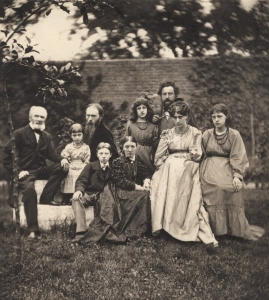
The Firm set up offices in London, and began to gain great commercial success. However, around this time, Morris's personal fortunes took a turn for the worst, and in 1865 he was forced to give up Red House, which was, in any case, inconveniently far from the Firm's headquarters in London. His marriage was also disintegrating: though he had lived happily with Jane and their two daughters at Red House for a time, she had recently struck up what became a long-term affair with Morris's friend and mentor Rossetti. Morris took solace in hard work and metered verse, and by the 1860s he had become one of the most famous poets in England. In 1871, he moved to a country house in Kelmscott in Oxfordshire with his wife, children, and, strangely enough, Rossetti. It has been surmised that Morris reluctantly allowed Rossetti to join them at Kelmscott for his wife's sake, but in spite of this remarkably magnanimous gesture, the domestic situation created tension between the pair, and Rossetti eventually left in 1874.
Late Period
In 1875, Morris dissolved The Firm and set up Morris & Co, a company that continued trading for almost 50 years after his death. Although the company was liquidated in 1940, the British fabric and wallpaper manufacturer Sanderson & Sons purchased the design licenses, and so Morris's designs are still sold under his name today. He expanded the stylistic repertoire of floral wallpaper and fabric designs to an unprecedented degree, a mercurial inventiveness on which the commercial success of the company rested. Throwing himself into the theory and practicalities of the design process, he spent many hours learning how to print woodblocks and weave tapestries. Favoring medieval, artisanal techniques of dyeing and printing, his passion for the art of the past was also expressed through his co-founding of the Society for the Protection of Ancient Buildings, which protested against the restoration of historical buildings using modern methods. The society remains active today, and the ideas underpinning it - characterized by Morris as "anti-scrape" - are now widely accepted.
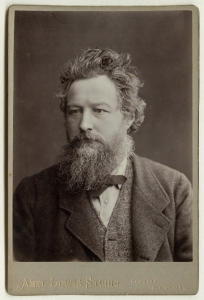
This was also a time of increased social consciousness for Morris. His views on craftsmanship, and his opposition to modern industrial methods, had already drawn him towards progressive causes. However, upon witnessing stark class inequalities across Europe, and becoming more well-versed in contemporary politics, Morris became a radical socialist. He wrote several popular books related to his cause, including the utopian socialist fantasy travelogue News From Nowhere (1890), and in 1874 founded a Socialist League in Hammersmith, West London, where the family had resettled in 1879. Like his undergraduate hero John Ruskin, Morris's political views were inseparable from his aesthetics. He believed that art should be produced and enjoyed by all; that the products of artistic labor should be offered back to the working classes.
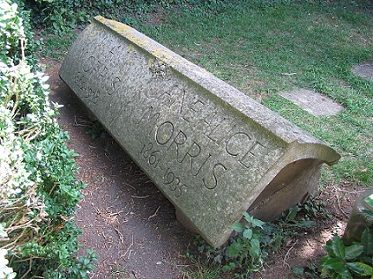
Morris spent the final years of his life in his new house in West London, affectionately referred to as Kelmscott House, in honor of his earlier country residence. In 1891, he launched the last of his many creative ventures, Kelmscott Press. He had long enjoyed creating intricately illustrated volumes of stories and myths, and he decided to set up a press which would produce beautiful illustrated books inspired by medieval ecclesiastical manuscripts. From that point onwards until his death in 1896, he divided his time between Kelmscott Press, his design work, and his socialist activism.
The Legacy of William Morris
The legacy of William Morris is as extensive as it is difficult to trace. His artistic and poetic skill, along with the radical new ethos on art and society that he espoused, sent shockwaves through the worlds of art, architecture, design, poetry, and political thought.
His most obvious impact was on the Arts and Crafts Movement, of which he is generally considered a founding father. Several of his friends and acquaintances, including his daughter May Morris, took up his mantle in the field of craft and design, while his work also resonated internationally, inspiring the development of Art Nouveau in France, as well as the North-American Arts and Crafts Movement.
His ideal of collaborative, artisanal community, exemplified by 'The Firm' and the construction of Red House, would inspire artists across the next century. Eric Gill would soon set up his own Catholic arts circle in Sussex, carrying forwards Morris's ideals of combining beauty and function through design and decorative lettering. Some decades later, the 1951 Festival of Britain took inspiration from Morris's socialist beliefs, and from his sense of the role of the community in artistic production, introducing these principles to a new generation of creatives including Terence Conran and Lucienne Day. The early-twentieth-century heyday of the artistic avant-garde was also in a very real sense preceded by the utopian collectivism of Morris's ventures.
The unity of architecture and decoration embodied in Red House also had an irrevocable effect on architectural philosophy across the coming decades, fundamentally influencing the way in which buildings were conceived and designed. Charles Rennie Mackintosh would expand on Morris's ideas by devising each of his buildings as a 'total work of art', in which décor, furniture, and architectural elements all fitted around each other. Even Frank Lloyd Wright and Walter Gropius, architects who produced sleek and refined modernist masterpieces, freely admitted the impact of Morris's work on their early development. Morris's thoughts on the relationship between country and city, meanwhile, and how the two might be combined, can be sensed in the socially egalitarian concept of the Garden City, borne out in early-twentieth-century project such as Welwyn Garden City.
Many contemporary artists still look back to Morris as an inspirational figure. Jeremy Deller and David Mabb, for example, have both commented on how Morris's work contrasts with and compliments the production methods and political ethos of much twentieth-century art.
Influences and Connections

-
![John Ruskin]() John Ruskin
John Ruskin - Thomas Mallory
- Thomas Carlyle
- Charles Kingsley
- Frederick Denison Maurice
-
![Dante Gabriel Rossetti]() Dante Gabriel Rossetti
Dante Gabriel Rossetti -
![Ford Madox Brown]() Ford Madox Brown
Ford Madox Brown ![Edward Burne-Jones]() Edward Burne-Jones
Edward Burne-Jones- Philip Webb
- Peter Paul Marshall
-
![Romanticism]() Romanticism
Romanticism -
![The Pre-Raphaelites]() The Pre-Raphaelites
The Pre-Raphaelites - Medievalism
- The Nazarenes
![William De Morgan]() William De Morgan
William De Morgan- May Morris
- William Arthur Smith Benson
-
![Arts and Crafts Movement]() Arts and Crafts Movement
Arts and Crafts Movement -
![Symbolism]() Symbolism
Symbolism -
![Art Nouveau]() Art Nouveau
Art Nouveau - Aestheticism
- Weiner Werkstätte
Useful Resources on William Morris
- William Morris By Himself; Designs and WritingsOur Picked. Gillian Naylor
- William Morris: A Life for our TimeOur PickBy Fiona MacCarthy
- William Morris: Art and Kelmscotted. Linda Parry
- William Morris: Romantic to RevolutionaryBy E.P. Thompson
- Questions of Travel: William Morris in IcelandBy Lavinia Greenlaw
 Ask The Art Story AI
Ask The Art Story AI